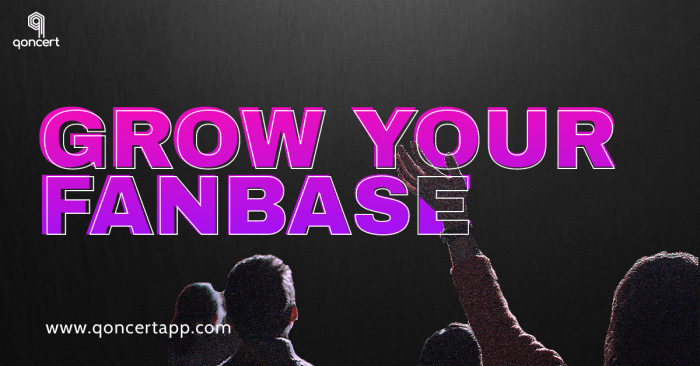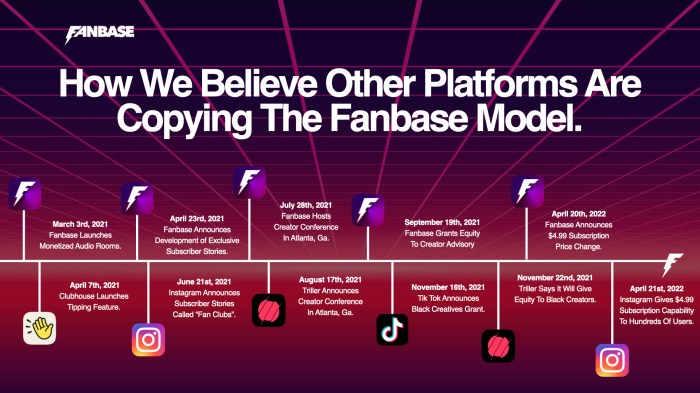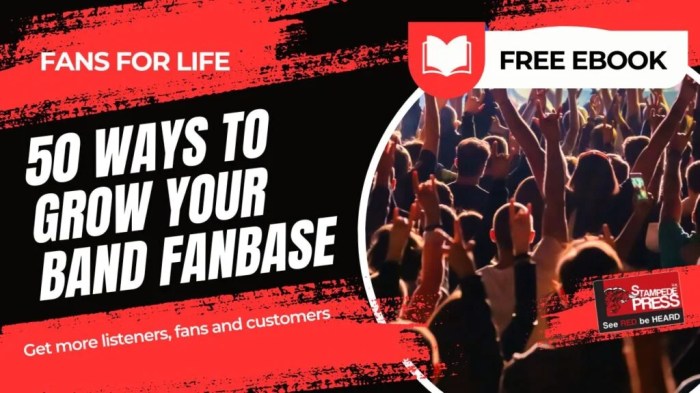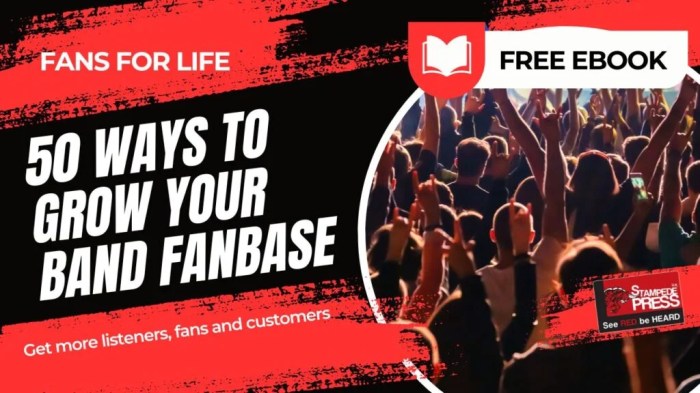Fanbase Growth is the holy grail for any creator, brand, or organization trying to build a loyal following. It’s not just about numbers; it’s about cultivating a community that genuinely connects with your work. This deep dive explores how to define your target audience, craft killer content, leverage social media, build a thriving community, and measure your success – all while keeping it real and relatable.
We’ll cover everything from identifying your ideal fan to analyzing your performance and adapting your strategies based on data. Think of it as your ultimate guide to turning casual viewers into dedicated fans who champion your cause (or your awesome band!). Get ready to level up your fanbase game.
Community Building and Engagement

Building a strong, engaged fanbase isn’t just about attracting followers; it’s about fostering a genuine community where fans feel valued, connected, and invested in your content. This involves proactive strategies to encourage interaction and cultivate a sense of belonging. Think of it less as a broadcast and more as a conversation.Creating a thriving online community requires consistent effort and a genuine interest in your audience.
By implementing thoughtful strategies, you can transform casual followers into passionate advocates. This leads to increased brand loyalty, organic reach, and ultimately, sustainable fanbase growth.
Methods for Fostering Community
Building a strong sense of community involves creating spaces for interaction and shared experiences. This can be achieved through various methods. For example, creating a dedicated Discord server allows for real-time interaction, fostering a sense of shared identity amongst fans. Similarly, hosting regular live streams provides a platform for direct engagement, answering questions, and showcasing behind-the-scenes content.
This creates a more personal connection with fans than a simple social media post. Another effective strategy is to encourage fan-generated content by hosting contests or challenges where fans can showcase their creativity and passion. This gives fans a voice and actively involves them in your brand’s story. Finally, creating themed events or challenges around specific content releases generates excitement and encourages collective participation.
For instance, a watch party for a new video release can create a shared experience and foster a sense of togetherness.
Responding to Fan Comments and Feedback
Prompt and engaging responses to fan comments and feedback are crucial for building trust and loyalty. A simple “thanks for the feedback!” isn’t enough; genuine interaction shows you value their input. Implementing a system for monitoring comments across all platforms ensures nothing is missed. This could involve assigning team members specific platforms or using social media management tools.
Responding thoughtfully, even to critical feedback, demonstrates professionalism and a willingness to engage with all aspects of fan interaction. Acknowledging and addressing concerns directly shows you are listening and care about their opinions. For example, if a fan expresses concern about a specific aspect of your content, acknowledging their feedback and explaining your reasoning builds trust. Furthermore, incorporating fan suggestions into future content shows you value their contributions and makes them feel heard.
Interactive Content for Increased Participation
Interactive content is key to keeping fans engaged and encouraging participation. Polls on social media are a simple yet effective way to gauge audience preferences and involve them in decision-making processes. For example, a poll asking fans which topic they’d like to see covered in your next video encourages active participation and provides valuable data. Regular Q&A sessions, either live-streamed or through dedicated posts, allow for direct interaction and provide opportunities to answer fan questions and address concerns.
Contests and giveaways, such as a drawing for merchandise or early access to new content, incentivize engagement and build excitement. Remember to keep the contests relevant to your brand and audience interests. For example, a photo contest themed around your latest video or product encourages fans to engage creatively with your content. These interactive strategies transform passive consumption into active participation, fostering a more loyal and engaged fanbase.
Analyzing and Adapting Strategies: Fanbase Growth

Building a thriving fanbase isn’t a set-it-and-forget-it process; it requires constant monitoring, analysis, and adaptation. Understanding what works and what doesn’t is crucial for maximizing your reach and engagement. This involves tracking key metrics, comparing different approaches, and using the data to refine your strategy over time. Think of it like A/B testing, but on a much larger, more dynamic scale.Analyzing your performance allows you to identify what resonates with your audience and what falls flat.
This iterative process is key to sustained growth. By understanding your audience’s preferences and behaviors, you can create content that truly connects and fosters a loyal community.
Key Performance Indicators (KPIs) for Fanbase Growth
Several key metrics provide valuable insights into your fanbase’s growth and engagement. Tracking these KPIs enables data-driven decision-making, moving beyond guesswork to strategic adjustments. Focusing on these metrics helps you understand the effectiveness of your efforts and make informed choices about future content and strategy.
- Follower Growth Rate: This measures the increase in followers over a specific period (e.g., weekly, monthly). A consistent upward trend indicates successful growth. For example, a 5% weekly increase is a strong indicator of positive momentum.
- Engagement Rate: This represents the level of interaction your content receives (likes, comments, shares, saves). A higher engagement rate signifies content resonance and audience connection. For instance, a 10% engagement rate on Instagram is generally considered good, while a 20% rate is exceptional.
- Website Traffic from Social Media: Tracking website visits originating from your social media platforms helps determine how effectively your social media efforts drive traffic to your primary online presence. A significant increase in website traffic from a particular platform suggests a successful strategy on that platform.
- Conversion Rate: This measures the percentage of followers who take a desired action (e.g., signing up for a newsletter, making a purchase). A higher conversion rate indicates effective strategies in driving audience actions towards specific goals.
Comparing Content Performance and Social Media Strategies
Direct comparison of different content types and social media platforms is essential for optimizing your overall approach. This involves analyzing which platforms and content formats yield the best results in terms of engagement and follower growth. This allows for resource allocation towards the most effective strategies, maximizing impact and efficiency.
| Platform | Content Type | Engagement Rate | Follower Growth | Notes |
|---|---|---|---|---|
| Reels | 15% | 10% weekly | High visual appeal drives engagement. | |
| TikTok | Short-form videos | 20% | 12% weekly | Trendy audio and challenges boost visibility. |
| Threads | 8% | 5% weekly | Engaging discussions drive followers. |
Using Data to Refine Content Strategy
Data analysis is not just about collecting numbers; it’s about understanding thewhy* behind those numbers. By analyzing the data gathered from your KPIs and content performance comparisons, you can identify patterns, strengths, and weaknesses in your strategy. This iterative process allows for continuous improvement and optimization of your approach.
“Data is the new oil, but only if you know how to refine it.”
Using the data, you can refine your content calendar, focusing on the types of content and platforms that resonate most with your audience. For example, if Reels perform significantly better than static images on Instagram, you should allocate more resources to creating engaging short-form videos. This data-driven approach ensures you are maximizing your efforts and reaching your target audience effectively.
Collaborations and Partnerships

Collaborating with other creators and businesses is a powerful strategy for expanding your fanbase. By leveraging existing audiences and resources, you can significantly increase your reach and engagement, leading to faster growth than you could achieve alone. This involves carefully selecting partners whose audiences align with yours and planning a collaborative strategy that benefits everyone involved.Successful collaborations require strategic planning and execution.
Ignoring the potential pitfalls can lead to wasted effort and even damage your brand image. This section will explore effective strategies for finding and working with partners, highlighting both the advantages and challenges inherent in collaborative fanbase growth.
Successful Collaboration Examples
Several successful collaborations demonstrate the power of strategic partnerships. For example, imagine two YouTubers, one specializing in gaming and the other in cooking, collaborating on a video series. The gaming YouTuber’s audience might be introduced to the cooking channel, and vice-versa, resulting in a mutual expansion of their fanbases. Another example could involve a small clothing brand partnering with a popular influencer to promote their products.
The influencer’s endorsement lends credibility and reaches a wider audience than the brand could reach on its own. These collaborations succeed because they offer mutual benefit and appeal to overlapping (yet distinct) audiences. A final example would be two podcasters in similar niches, but with different strengths, cross-promoting each other’s episodes. This allows them to reach new listeners who might not have found them otherwise.
Identifying and Reaching Out to Potential Partners, Fanbase Growth
A well-defined strategy is crucial for identifying and approaching potential partners. Begin by creating a list of creators or businesses whose audiences align with yours. Consider factors like audience demographics, content style, and brand values. Research their engagement rates and audience size to assess their potential value as partners. Once you’ve identified potential partners, reach out to them professionally, proposing a collaboration that offers mutual benefits.
A clear proposal outlining the goals, deliverables, and timelines for the collaboration will increase the chances of a successful partnership. This might involve a joint social media campaign, a co-created video, or a cross-promotion of each other’s products or services. Remember to emphasize the value proposition for each party involved.
Benefits and Challenges of Collaborative Fanbase Growth
Collaborative initiatives offer several key benefits. Increased reach and brand awareness are paramount, expanding your audience significantly faster than solo efforts. Furthermore, collaborations can foster stronger relationships with your audience by showing them that you are connected within a community and working with people they also appreciate. It also provides opportunities for cross-promotion, increased engagement, and access to new resources and expertise.
However, challenges exist. Finding compatible partners who align with your brand and values is crucial; a mismatch can damage your reputation. Additionally, coordinating efforts and managing expectations across multiple parties can be complex and time-consuming. Finally, ensuring that the collaboration aligns with your overall brand strategy is essential to avoid inconsistencies and confusion among your audience.
Answers to Common Questions
What if my target audience is really diverse?
That’s totally okay! You can create different content pillars to appeal to various segments within your audience. Think of it like creating different playlists on Spotify – something for everyone.
How much should I spend on paid advertising?
Start small and test different campaigns to see what works best. Allocate a budget you’re comfortable with and track your ROI closely. Don’t be afraid to adjust your spending based on results.
What if my engagement is low?
Don’t panic! Analyze your content, audience engagement, and posting times. Experiment with different content formats, engage directly with comments, and consider running contests or polls to boost interaction.
How do I measure success beyond just follower count?
Look at engagement metrics like likes, comments, shares, website traffic, and conversions (if applicable). These offer a more holistic view of your fanbase’s connection with your brand.
